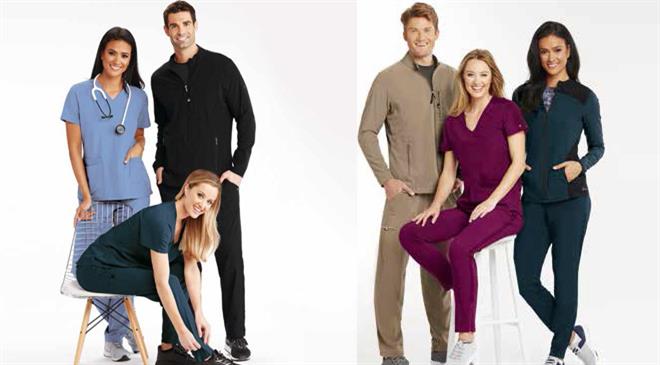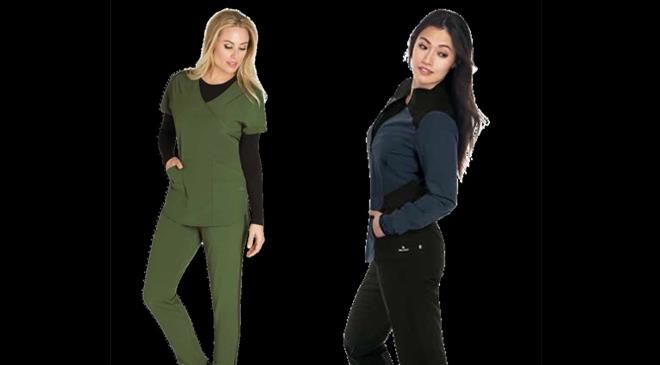Interview with Michaela Griggs & Peggy Schulz
Fashionably wearable
Founded in 1929, Barco Uniforms started as an apparel company for beauty professionals. It went on to produce its first medical uniform in 1936 under the leadership of Kenneth Donner. Barco was the first to merge fashion with uniform design in 1941, putting the company on the national stage by designing a dress for nurses made of a nylon fabric originally made for the military defence department to make parachutes for the war. It remains a leader of design innovation in the premium professional apparel industry, and is headquartered in Los Angeles, United States with 225+ local employees across multiple disciplines including design, product development, marketing, sales, supply chain, and distribution. Michaela Griggs, senior vice-president (Healthcare Division) and Peggy Schulz, vice-president of Corporate Marketing talk medical wearables with Subir Ghosh.
TT: Medical wearables are going to be big in the days to come? How "big" is "big"?
Medical wearables are a sustainable business for the future. It will be a large industry covering multiple sectors. It is almost impossible to project how "big" is "big" as it spans so many categories from electronics, technology, med-device to fibres, fabrications and surface applications for fabrics.
TT: What do you think would be the driving force for this sector? Would it be performance-driven? Or, would there be other equally major contributing factors?
The key driving force behind medical wearables is the consumers' desire to be more knowledgeable, aware and in charge of their own health. They desire information about their own health and want products that are health promoting and/or enhancing. Also, there is a movement towards proactive health and preventative care. Medical or wellness wearables are certainly a way to maintain a healthier lifestyle and help ward-off unhealthy conditions.

TT: In what ways do you see medical wearables revolutionising healthcare?
With more information consumers are able to be proactive about healthcare and enhancing or protecting their own well-being.
TT: When we use the term "healthcare", it necessarily means ordinary people. Would next-gen medical wearables result in the overall healthcare costs spiralling up?
Next-gen medical wearables have the opportunity to help temper the spiralling cost of healthcare by providing consumers more information to be proactive about their health or to help flag early warning signs. Additionally, providing wellness benefits that work with the body's own healing systems to promote healing, provide comfort or prevent unhealthy conditions from developing proactively.
TT: For all this to be truly universal, there are other factors that need to play out: technology transfer, lower mass production costs, etc. Though these are early days yet, what are the developments on this aspect that you are noticing?
Like all products as technology adoption deepens, a long-term cost saving can be identified through mass production, ongoing innovation and more efficiencies in research & development (R&D).
TT: What about checks and balances? This sector is progressing far too fast and wide, and government policies and regulatory compliances are way too behind to catch up. Your comments, please.
The need for regulation depends on the claims being made. There is less concern regarding regulatory oversight so long as products are offering information that the wearer can utilise to make improve healthcare decision in partnership with their healthcare provider vs erroneously being used to diagnose.

TT: There are sensors, materials and fabrics (not to leave out design). What are the changes on these fronts that we will soon see? Medical wearables are not just about fibres and fabrics. Those are as much about electronics and data. How do you see these intersections working out?
Innovation regarding fabric that can enhance wellness is an interesting area of R&D not only for apparel companies like Barco, but also in the consumer goods industry where fibres may be used in the fabrication of products that impact the overall quality of life in or around the home. We eat, sleep, live and interact with fabric every day of our lives. That is why Barco offers healthcare professionals a unique scrub line curated from a fabric that is infused with bio-minerals. Barco One Wellness raises the bar on delivering innovative purposeful technology, comfort and style to help healthcare professionals not only look their best, but also feel their best and improve their performance on the job.
Barco One Wellness is the first-ever scrub collection infused with health-promoting bio-minerals aimed at helping the body's thermoregulation and recovery-a necessity for busy healthcare professionals who work vigorously to care for others. These infused bio-minerals are found to enhance blood circulation and increase tissue oxygenation, as well as maintain consistent optimal body temperature by circulating energy back through the body. As the first company to incorporate a Far Infrared, reflective finish on the inside of the fabric of its scrubs, Barco's new Barco One Wellness apparel line harnesses the energy from the infrared spectrum that is likely to have restorative benefits, with the goal of promoting recovery for the wearer's body. The natural mineral-based elements of elvan, amethyst, red clay, platinum and germanium interact with the human body. The bio-mineral infused fabric promotes relaxation for a deeper sleep and supports the reduction of inflammation and stimulates natural cell regeneration. Barco One Wellness is uniquely designed to help busy health care professionals perform at their peak consistently every single day. The initial product line launched under the Barco One brand transformed the healthcare apparel industry with, purposeful, performancedriven innovation using a sustainable fabric technology with fibres made from recycled plastic water bottles. The Barco One brand's revolutionary, break-through eco-friendly technology reduces the carbon footprint significantly by using 10 recycled plastic bottles per scrub set.
TT: There are countless start-ups working in this sector. How do you see the business landscape changing? Are we likely to see more M&A in this sector? Or will big players co-exist with small ones?
For over nine decades, Barco has maintained its position as the leader of meaningful scrub brands that are innovative, modern and relevant. Unlike trendy brands that come and go, our brands are recognised and respected globally by millions of healthcare professionals who have chosen to wear our scrubs since the beginning of their career and they remain loyal. Barco continues to pour passion for modern, relevant design and thirst for cutting-edge fabric technology into its scrub brands, keeping consumers coming back for more.

